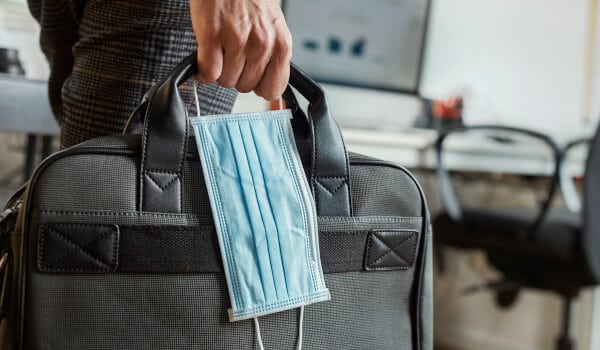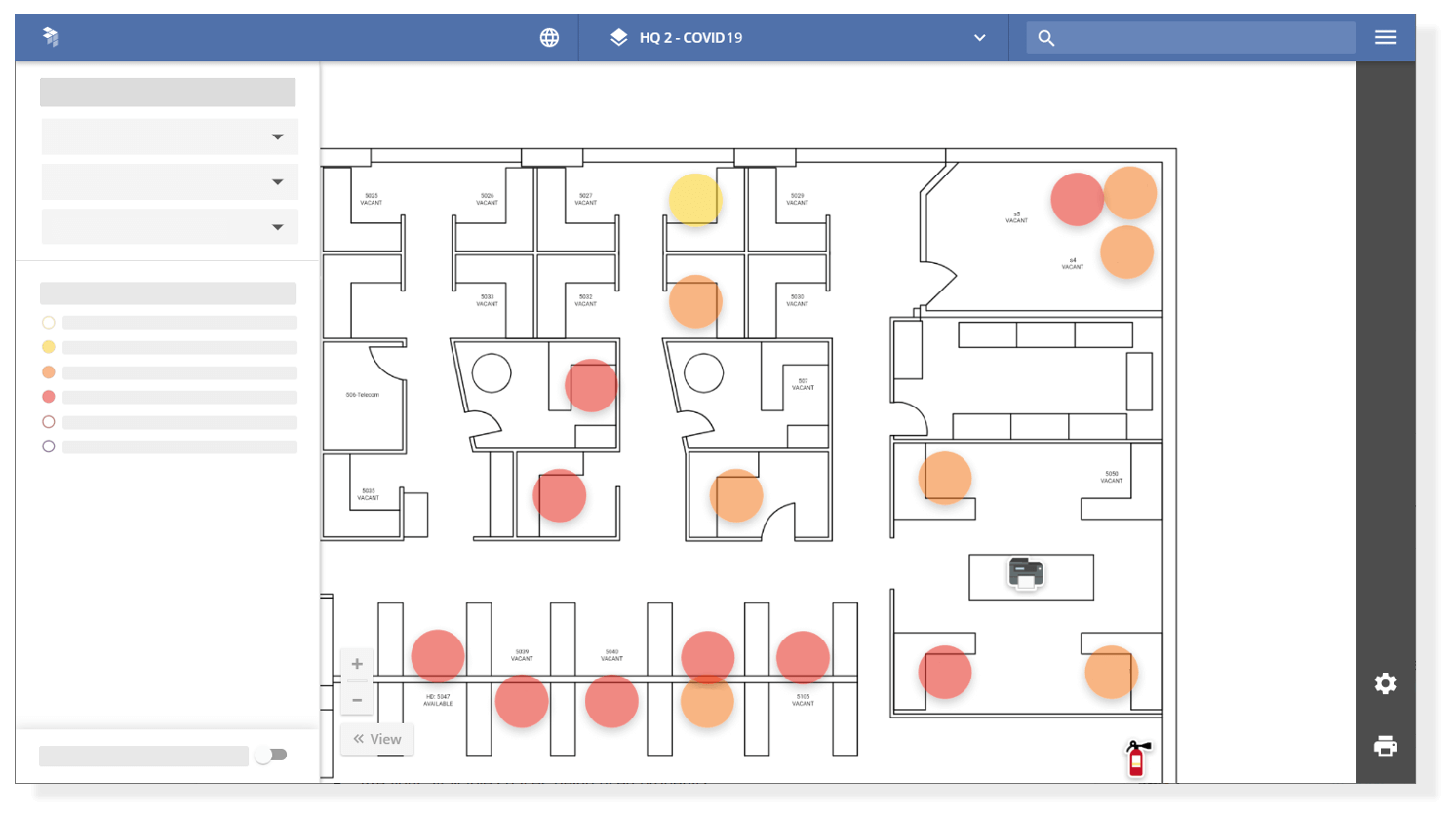
Local governments all seem to have a different plan on when to return to the workplace. While some employees are still working remotely with no end date in sight, others in states like Texas and Vermont are already returning to the office.
To help you create a safe, phased return to the workplace for your people—no matter where your local authorities stand on the issue—here’s how OfficeSpace can help.
Quick links
- Create safely distanced seating plans
- Easily reconfigure your physical floor plans
- Create a desk sharing plan that keeps employees safe
- Bring employees back to the office in shifts
- Monitor employee attendance to support contact tracing initiatives
- Support WFH employees
Create safely distanced seating plans
To comply with workplace distancing guidelines, you’ll need to figure out how to seat employees six feet apart. The catch? You’ll need to do that with an extremely reduced total seating capacity.
Distancing Planner can help you instantly visualize and implement a safe seating plan. This feature uses AI technology to generate seating plans that make the best use of your reduced seating capacity.
With Distancing Planner, you can:
- Create appropriately distanced seating plans that keep your people safe
- Quickly see the available seating capacity you can provide to returning employees
- View a six-foot radius around every seat on your floor plan
- Identify seats that are too close to one another and make them inactive in seconds
- Track your seating capacity in real-time and visualize the impact of different spacing setups
Easily reconfigure your physical floor plans
Making your floor plan COVID-19 compliant could mean you have to completely modify your facility.
Instead of trying to identify and implement all of the moves and floor plan changes you need to make with a spreadsheet, you can use Move Manager and Scenario Merge to take complexity out of the entire process.
First, design your future plan as a scenario in Move Manager. Scenarios are collaborative, so facilities teams can work with all relevant stakeholders to create and review different configurations.
Once everyone’s happy with the new setup, Scenario Merge will automatically identify every task that’s required to make your scenario floor plan a reality—move an employee from one seat to another, make changes to desks, rooms, and utilities. Every single change you need to make is identified and delivered to you visually inside OfficeSpace.
All you have to do is action each item in your physical space, and you’re done.
Create a desk sharing plan that keeps employees safe
Physically distanced seating plans and enhanced cleaning schedules will severely reduce seating capacity.
Desk booking software can help you implement a desk sharing program that makes the best use of your available seating, allows for enhanced cleaning, and keeps employees safe.
Encourage “No Touch” bookings and check-ins
Ask employees to book desks before they enter the workplace using a personal device (Desk Booking works on Android and iOS).
Help employees find desks remotely
Employees can also use OfficeSpace to view a virtual floor plan of your facility, locate available desks, and familiarize themselves with any recent floor plan changes before they arrive at the workplace.
Monitor desk usage and optimize your strategy
The reports inside Desk Booking show you the demand for seating throughout your facility, so you can keep improving your configuration as your plans evolve. If you see an opportunity to optimize your existing setup, it’s easy to switch any seat from “bookable” to “non-bookable” in seconds.
Schedule cleaning around bookable hours
To give your cleaning crews the time and physical distance they need to do their job, assign a single employee to a desk for a week and schedule daily overnight cleaning.
If additional cleaning is required, use Booking Manager to see which employees will be using each desk throughout the day and schedule your cleaners to arrive between each handover.

Bring employees back to the office in shifts
If your reduced seating capacity isn’t large enough to accommodate your entire workforce, you’ll likely need to bring your employees back to the office in rotating groups or “shifts”.
One strategy that’s emerging is the concept of 10-4 shifts. Following this model, employees would rotate between the office and working from home in two separate shifts, like so:
- Shift 1: Work at the office for four days, then
- Shift 2: Work from home for 10 days
The idea here is that if an employee contracts COVID-19, symptoms would begin to show up during their 10-day WFH shift.
Another approach involves employees working on alternating days during the week. For example:
- Week 1: work Monday/Wednesday/Friday from the office
- Week 2: work Tuesday/Thursday from the office
Staff can also be scheduled on alternating weeks, which brings 50% of the staff back into the office at a time.
No matter which shift-based strategy you choose to run with, you can make it easier for each shift of employees to know which desks they can use by color-coding seats on your floor plan.

Monitor employee attendance to support workplace distancing and contact tracing initiatives
It’s important to monitor who’s been in your facility and how your space is being used during the phased return to work. There are a couple of ways you can achieve this in OfficeSpace.
First, if your employees swipe a badge to get into the building, Badge Integration can display daily employee attendance as a heat map on your floor plan.
Using Badge Integration, you can:
- Run reports to see who actually arrived in your building on any given day
- Track in-office employees: where they sit, when they arrive
- Perform a contact tracing analysis if someone in your facility tests positive for the Coronavirus
- Visualize the daily usage of buildings, floors, and seats during the return to work, so you can best allocate your limited facility capacity

If your facility uses workplace sensors to monitor live presence detection, room usage, desk usage, and more, you can also use OfficeSpace to access in-depth sensor data and reports that answer questions like:
- Are your available spaces being used properly?
- Are too many people gathering in specific areas?
- Are the correct workstations occupied to maintain physical distancing?
- Do we have too many people returning to the office, or can we afford to safely bring more people back?
Support WFH employees
According to President of Global Workplace Analytics Kate Lister, many companies aren’t planning for more than 50% occupancy in their physical facilities before the end of the year.
Here’s how you can use OfficeSpace to support your employees while some of them—if not all of them—are working from home (WFH).

Keep remote employees connected and track of who’s WFH
Many of our clients are creating a “Work From Home Floor Plan” to track who’s working from home and help remote employees stay connected.
Employees can search for and connect with colleagues by finding them on a virtual map, just like they always have on the virtual floor plans in Visual Directory.
This map is completely customizable, so it can be as big as the entire country or be down as far as the local county within a specific state.
For privacy reasons, employee addresses are never shown.
Manage requests from remote employees
Your WFH employees could probably improve their home office setup with some of the unused equipment in your facility. And they may also need to ask your facilities and IT teams for some help with their remote-work setup.
You can make sure none of these requests slip through the cracks by streamlining the process with Request Manager. Here’s how it works.
First, have your remote employees submit a facility request using OfficeSpace (mobile app, web browser, desktop).
If your company has the OfficeSpace for Slack integration set up, employees can also simply type /request in any Slack channel to submit a facility request.
Once received, facilities teams can manage the request in Request Manager. Request status and request notifications are permanently saved in OfficeSpace, so your team will always have a centralized record of the requests they’ve handled for remote and in-office employees.
Track workplace resources loaned to WFH employees
If you do happen to loan any office equipment to employees during the work-from-home period, you’ll also want to make sure that it gets returned when employees come back to the workplace.
Resource Tracking can help facilities and IT teams tag and track the whereabouts of assets like chairs, standing desks, printers, computers, and anything else you’ve put on loan.
Tag all of the assets you loan to your remote employees, and update an asset’s status as “returned” once it’s been brought back to the office.
Need some help?
Thousands of companies are leveraging the features in OfficeSpace to create a safe return to the office for their employees.
If you’re struggling to overcome any COVID-19 workplace challenges as coronavirus guidelines continue to change, get in touch to discuss how OfficeSpace can help.
Photo Credits: iStock, OSS, Andrea Piacquadio, Glenn Carstens-Peters



